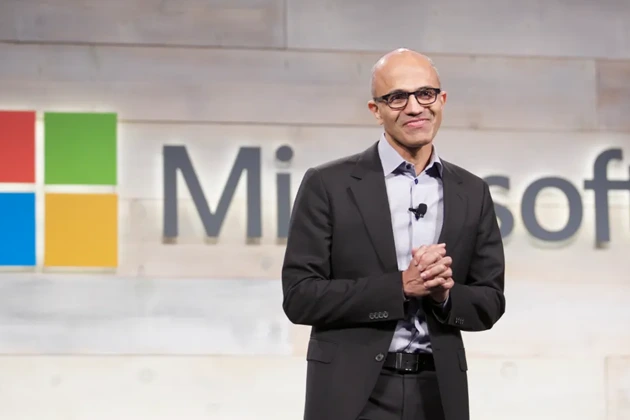Introduction
Microsoft continues to make laudable improvements in its product development process and ability to organize and share as a company. Its impeccable growth since its inception is a testament to excellence, innovation, and transformation coupled with exceptional leadership, especially of Satya Nadella, the CEO. While discussing 2024’s most inspirational leaders and icons, we cannot fail to honor Satya Nadella’s unparalleled contribution to inspiring others and taking Microsoft to a new height of success.
As a lodestar of innovation and adaptation, Microsoft has always remained at the forefront of the ever-evolving technological landscape. However, it was under his leadership since 2014 that the tech giant witnessed a remarkable transformation, marking him as one of 2024’s most inspirational leaders and icons in the world.
Microsoft Before Satya Nadella
The evolution of Microsoft as a tech giant is historic, and the way it continues to change the course of software development even today is outstanding. Microsoft was lucky enough to receive the leadership guidance of the world’s most inspirational leaders, starting with its founder and former CEO, Bill Gates.
The Bill Gates Era (1975-1999)
Paul Allen co-founded Microsoft with Bill Gates in 1975 in Albuquerque, New Mexico. As the chairman and CEO, Bill Gates had been a daunting force in transforming personal computing and software development systems with Microsoft until his exit in 1999. Under his leadership, Microsoft delivered its first operating system, ‘Microsoft Word’ for IBM PC.
The collaborative leadership of Allen and Gates has helped Microsoft capture a significant rise in revenue, from $16000 million in 1975 to about $6 billion in 1995. At the outset, the company started with one product and three people, which later evolved to two hundred products and approximately 17,800 employees during Bill Gates’s reign. His contributions to Microsoft’s growth remain inspiring for tech leaders even today, securing him a position in the list of 2024’s most inspirational leaders and icons alongside Satya.
Microsoft Under Steve Ballmer (2000-2014)
Steve Ballmer succeeded Bill Gates as the CEO and President of Microsoft in 2000. He recognized the need for agility in the rapidly changing tech industry and initiated an extensive internal reshaping of processes to adapt to speed. Ballmer’s contribution to the enterprise strategy of Microsoft, growing its bottom line, overseeing the Xbox launch, and fostering cloud investment is undeniable. During his tenure, the company experienced a considerable revenue growth of $25 billion in 2000 to over $77 billion in 2013.
Apart from process restructuring, Steve’s management style transformed Microsoft’s management system. His preference for a relatively unstructured environment has eliminated bureaucracy and embraced cultural diversity. Although this approach encouraged the open sharing of ideas, creativity, and innovation, the unstructured manner made program managers quite irrational. Under his leadership, Microsoft encountered some challenges, which led to his stepping down from the CEO position in 2014. Here are some of the biggest challenges faced by the company:
- i) Leadership Issues: Ballmer’s leadership lacked vision and cohesive strategy. His approach was frequently criticized for being too inward-looking and focused on incremental improvements.
- ii) Antitrust Issue: During his era, there were a lot of antitrust issues. The company was accused of monopolistic practices, which tarnished its reputation and pushed it away from innovation and growth.
- ii) Failure of Windows Phone: Although the company succeeded in multiple domains, it failed to be a fortress in the mobile phone market. With higher market competition from the iOS and the Android operating system, Microsoft’s Windows Phone operating system failed to hold a strong market position.
Despite the criticisms and challenges, Ballmer significantly influenced Microsoft’s growth. Soon, after Steve transitioned to the role of a technology advisor, Satya Nadella joined Microsoft in 2014 as the CEO.
Satya Nadella’s Journey with Microsoft
As one of 2024’s most inspirational leaders and icons, Satya Nadella’s journey with Microsoft is attributed to his exceptional leadership since 2014. Satya’s leadership is a testament to transformation, innovation, and growth, which reshaped Microsoft’s market position up until the present time. With his arrival as the CEO, Microsoft witnessed a noteworthy shift in its growth trajectory. Let us look at his leadership capabilities and their influence on the company.
Satya’s Leadership Principles
As an authentic leader, Satya Nadella garnered praises, such as “Fortune’s Businessperson of the Year 2019” and “Best CEOs for Diversity 2020”. Below are some of his attributes and principles underscoring his leadership:
-
Growth Mindset
One of the fundamental leadership principles was having a ‘growth mindset’ to foster learning, resilience, and adaptability. With this approach, Nadella reshaped Microsoft’s culture and innovation. He encouraged employees to embrace failure as a learning opportunity to facilitate innovation. Nadella’s leadership is focused on team empowerment to cultivate their highest potential.
-
Continuous Learning
Continuous learning lies at the heart of Nadella’s leadership style. He motivates employees to innovate and develop new technology through continuous learning.
-
Empathy and Collaboration
Nadella changed the leadership approach of Microsoft by embracing a culture of individual empowerment, empathy, collaboration, positivity, and employee growth. As an empathetic and inclusive leader, he prioritizes diversity to generate innovative ideas.
-
Innovation and Acquisition
The open work environment and brainstorming sessions gave way to creativity in the company. His encouragement of employees helps them come up with new innovative ideas by studying the market. Nadella’s investment in cloud computing has led to the development and expansion of Microsoft Azure.
On the contrary, he collaborated with competitors to embrace innovation. With his strategic acquisitions of LinkedIn and GitHub, the company expanded its innovation capabilities.
-
Exceptional Communication
Satya Nadella excels in communicating by clearly expressing his strategic visions to his employees. This communication ability cultivated a workforce that is adaptable and creative. By achieving transformational leadership, Nadella focused on individual development and aligned his vision with company capabilities.
Nadella’s Impact on Microsoft’s Growth
Nadella’s leadership has had a multi-dimensional impact on Microsoft that made him one of 2024’s most inspirational leaders and icons. Read ahead to discern his impacts on the company’s growth.
Exploring Strengths
Shifting to Cloud Computing
One of the most substantial impacts includes Nadella’s shift to cloud computing with Microsoft Azure. This cloud platform provides an array of services, including computing, storage, analytics, and networking. Right now, Azure is giving strong competition to Amazon Web Services (AWS) cloud platform. Azure solidified Microsoft’s market position as a leading cloud service provider and boosted its revenue.
Cultural Transformation
An inclusive work culture is a cornerstone of Microsoft’s success. His emphasis on motivation, empathy, team development, and collaboration has facilitated innovative ideas and creativity among its workforce.
Strategic Acquisitions
His strategic acquisitions expanded Microsoft’s capabilities. Nadella aligned the company’s growth objectives with the acquisitions of LinkedIn in 2016 and GitHub in 2018 to build a robust market presence. With LinkedIn, the company strengthened its social and professional networking in the business world. On the other hand, with GitHub, Microsoft strengthened its position in the software developer community.
Revenue Growth
According to Microsoft’s financial report for 2024, the company has earned a revenue of $245 billion, which is 16% higher than its previous revenues year-over-year. This reflects Nadella’s exceptional leadership approach to accelerating organizational earning.
Overcoming Hurdles
Intense Market Competition
In the last few decades, companies like Amazon, Google, and Apple remained tough competitors of Microsoft. With Nadella’s innovation-focused approach, the company has invested heavily in innovation in cutting-edge technologies to stay competitive.
Resistance to Change
The deeply ingrained culture of Microsoft was tough to change. However, with his visionary and strategic leadership, Nadella overcame all resistance to change. He articulated his vision clearly to the employees to align the workforce with the change objectives. Through proper training and development programs, Nadella empowered employees to help them easily adapt to the changing environment.
Change Integration
Integrating change and acquisitions remained a challenge for him. By establishing a dedicated team, Nadella integrated technologies and acquired companies within the work culture.
Conclusion
Satya Nadella exemplifies himself as a transformational and authentic leader who prioritizes innovation, empathy, and collaboration alongside team development, employee satisfaction, and strategic growth in Microsoft. His exemplary leadership pushed Microsoft to the peak of success by helping it become one of the leading technology companies in the world.
A perfect blend of strategic direction and cultural transformation shapes Nadella’s leadership attributes, underscoring his position as one of 2024’s most inspirational leaders and icons. Under his tenure, Microsoft has witnessed dramatic growth, unlocking long-term success in the near future.










